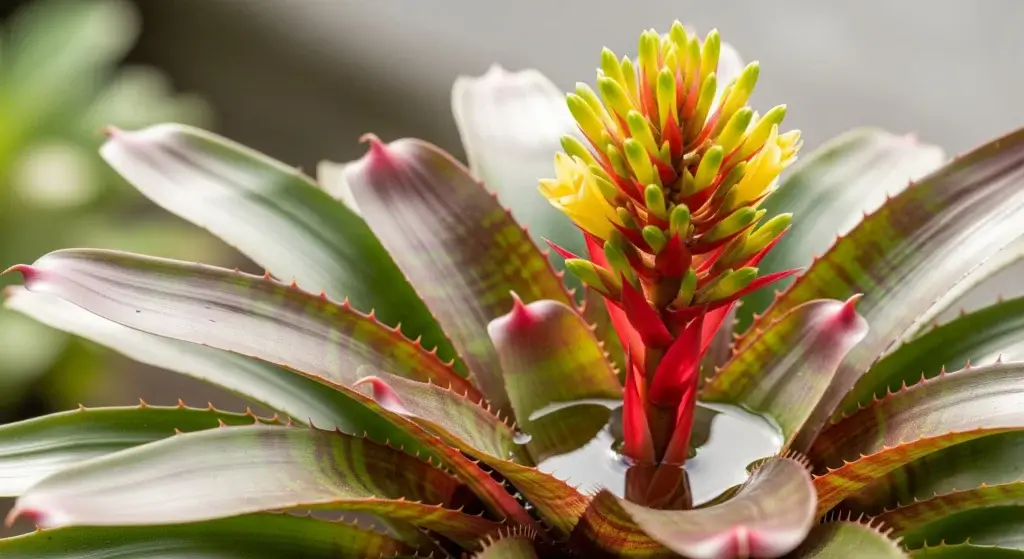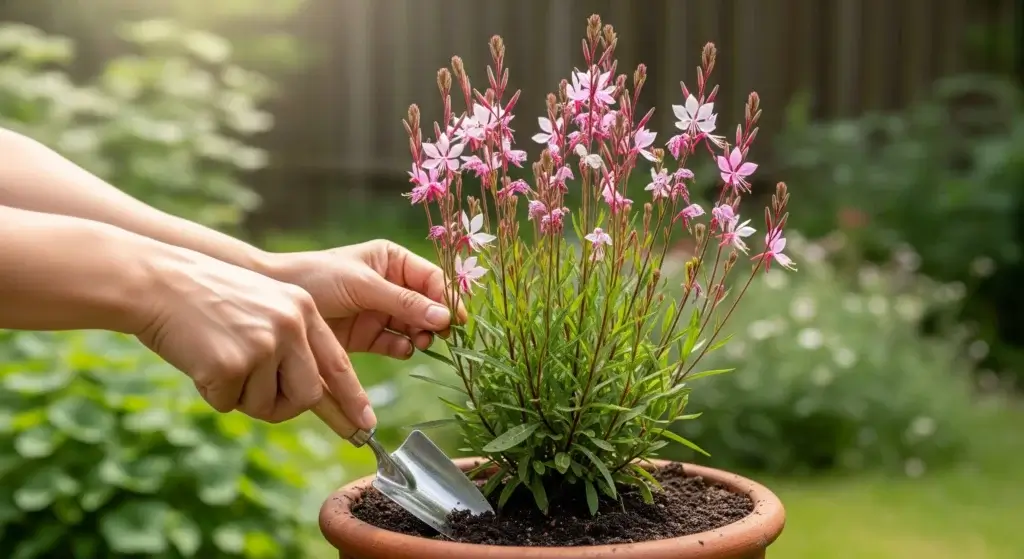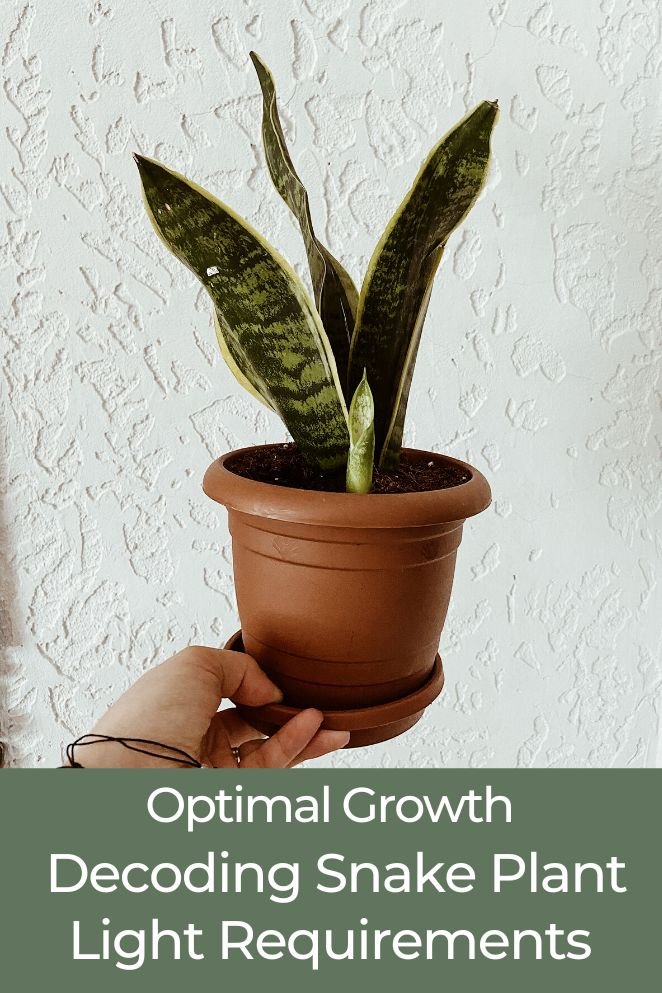
Low-maintenance and adaptable, snake plants, scientifically known as Sansevieria, make excellent houseplants.
Flourishing in diverse light conditions, it’s crucial to grasp their specific light requirements to ensure optimal growth and overall health.
Understanding these needs is key to fostering a thriving environment for these resilient indoor plants.
Snake Plant Care Light Requirements
When caring for snake plants, it’s essential to consider their light requirements.
These adaptable houseplants generally thrive in low to medium light conditions.
While they can tolerate higher light levels, direct sunlight should be avoided, as it may lead to sunburn.
Understanding and providing the right light conditions contribute to the overall health and well-being of snake plants.
- Read also: Why Your Snake Plant Leaves Are Curling
- Read also: Understanding Why Is My Snake Plant Drooping
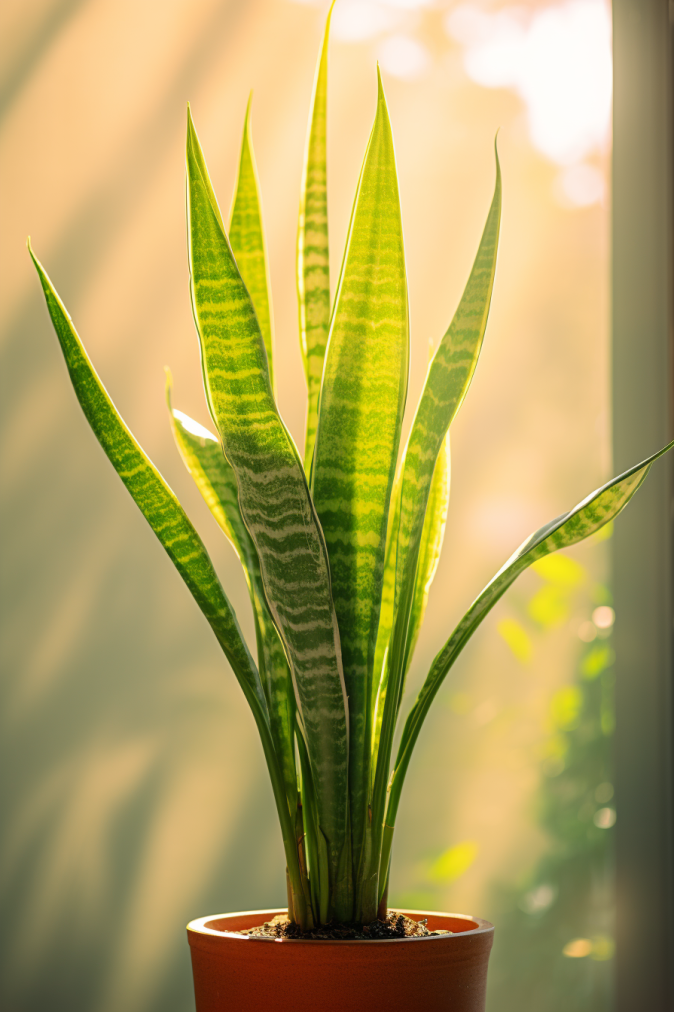
Different Snake Plant Light Conditions
Snake plants can adapt to various light conditions, each affecting their growth and appearance differently:
Low light conditions
Snake plants can survive in low-light environments, such as areas with minimal natural light or rooms with few windows.
While they can endure these conditions, their growth may be slower compared to plants receiving more light.
In low light, snake plant leaves may stretch or become elongated as the plant reaches for available light.
Despite this, they can still thrive, making them excellent choices for spaces with limited sunlight.
Medium-light conditions
Optimal for snake plants, medium light conditions provide just the right amount of light for healthy growth and vibrant foliage.
In areas with moderate natural light, such as near north-facing windows or in rooms with filtered sunlight, snake plants flourish.
In these conditions, they maintain their characteristic green coloration and exhibit robust growth, producing sturdy leaves that stand upright.
High light conditions
While snake plants can tolerate high light conditions, caution should be exercised, particularly with direct sunlight exposure.
When placed in areas with intense sunlight, such as near south-facing windows or in unshaded outdoor locations, snake plants may experience sunburn.
Direct sunlight can cause damage to their leaves, resulting in unsightly browning or yellowing.
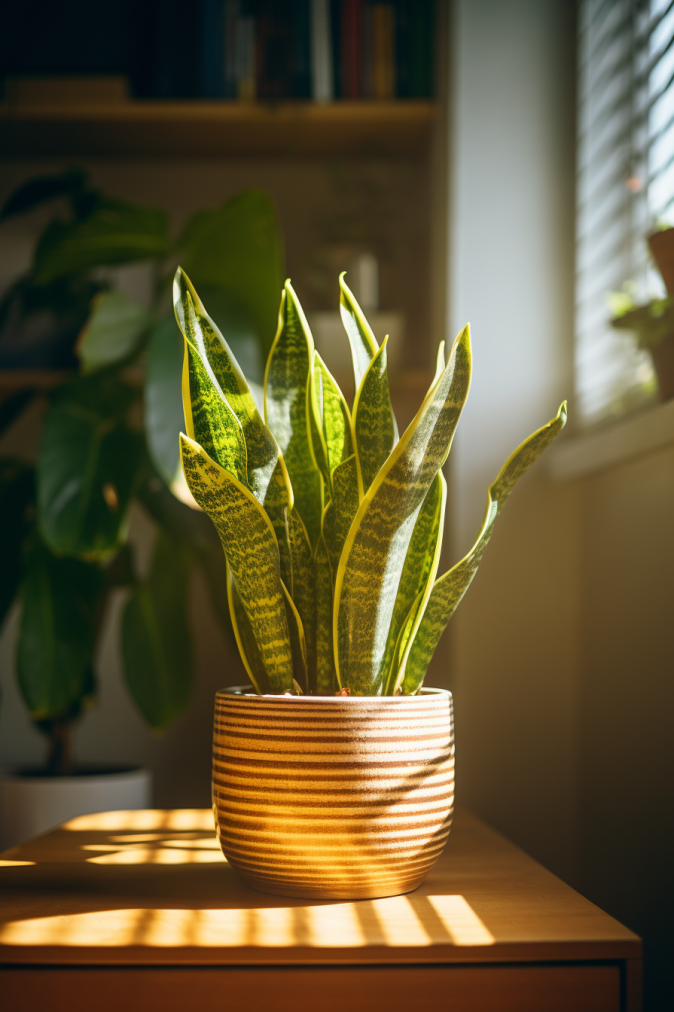
How to Grow Snake Plants With Artificial Light?
Growing snake plants with artificial light is a viable option, offering flexibility in cultivating these resilient plants.
Different types of artificial lights can be employed, each with its own characteristics:
Fluorescent lights
Fluorescent lights are a popular choice for growing snake plants indoors.
They provide a full spectrum of light, closely resembling natural sunlight.
This broad spectrum is beneficial for overall plant growth and development.
When using fluorescent lights, it’s advisable to position them at an optimal distance from the snake plant to ensure adequate light exposure.
Incandescent lights
Incandescent lights emit a warm light and can be utilized for growing snake plants.
However, they may not offer the full spectrum of light required for optimal growth.
While suitable for supplementing natural light, incandescent lights are often used in conjunction with other light sources to ensure the snake plant receives a diverse range of wavelengths beneficial for photosynthesis.
LED lights
LED lights are energy-efficient and have gained popularity for indoor plant cultivation.
While they can be used to grow snake plants, some LED lights may not provide the complete spectrum necessary for optimal growth.
Choosing LED lights with a balanced spectrum or combining different types of LEDs can enhance their effectiveness in supporting snake plant development.
Halogen lights
Halogen lights emit a warm light and can contribute to the growth of snake plants.
However, like incandescent lights, they may not offer the full spectrum essential for optimal plant development.
Halogen lights can be used as supplemental lighting, particularly in spaces where a mix of light sources is employed to create a more balanced environment.
Signs Your Snake Plant Needs More or Less Light
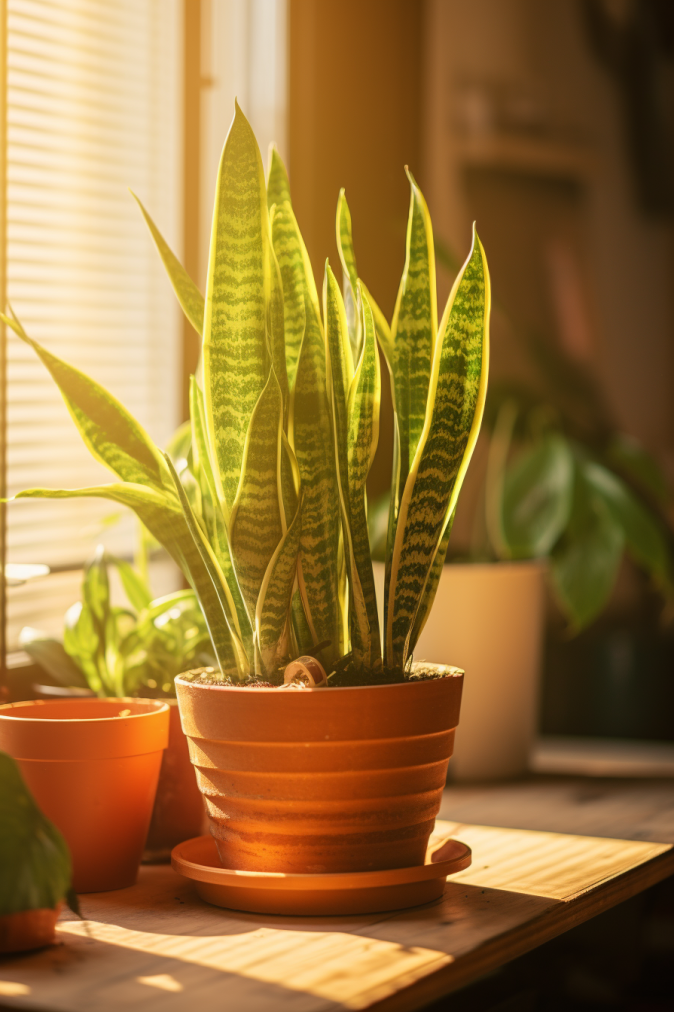
Signs of Sunburn in Snake Plants
Sunburn in snake plants manifests as distinct indicators on their leaves, typically appearing as brown or yellow spots.
These discolorations signal that the plant has been overexposed to sunlight.
The intensity and duration of sun exposure influence the severity of sunburn, and it’s essential to recognize these signs early to prevent further damage to the plant.
How to Fix Snake Plants Overexposed to Sunlight
Corrective actions are crucial when snake plants experience sunburn due to overexposure. Here are practical steps to remedy the situation:
Move to a shadier location
Relocate the snake plant to a shadier location where it receives filtered or indirect sunlight.
This helps reduce the intensity of light exposure and minimizes the risk of further sunburn.
Indoors, consider placing the plant away from direct sunlight or moving it to a different room with less intense light.
Use sheer curtain
Details: Installing a sheer curtain can serve as a simple yet effective solution.
This helps filter the incoming sunlight, diffusing its intensity and providing a more gentle illumination for the snake plant.
Adjust the curtain to control the amount of light reaching the plant, ensuring it receives an optimal balance for healthy growth.
Monitor light conditions
Regularly monitor the light conditions in the plant’s environment.
Be attentive to changes in the sun’s position throughout the day, especially if the plant is near windows.
Adjust the positioning of the snake plant accordingly to maintain an ideal balance between light exposure and protection from intense sunlight.
Hydration and recovery
Ensure that the snake plant remains adequately hydrated during and after sunburn.
Water the plant as needed, considering factors like soil moisture and environmental conditions.
Providing optimal hydration supports the recovery process, allowing the plant to recover from the effects of sunburn.
Signs of Low Light Exposure
Identifying signs of low light exposure in snake plants is essential for their overall health.
Common indicators include pale leaves and slower growth. When snake plants don’t receive sufficient light, their leaves may lose their vibrant green color, appearing paler than usual.
Additionally, the plant’s growth rate may slow down as it struggles to produce energy through photosynthesis.
How to Manage Low Light Conditions
Effectively managing low light conditions is crucial to ensure the health and vitality of snake plants.
Here are practical steps to address and improve low-light exposure:
Artificial light sources
Supplement natural light with artificial light sources, such as fluorescent or LED lights. Position these lights strategically to provide additional illumination to the snake plant.
This is particularly beneficial in spaces with limited access to natural sunlight, ensuring the plant receives the light energy necessary for photosynthesis and growth.
Placement near windows
If natural light is available, place the snake plant near windows with filtered light.
North-facing windows often provide indirect sunlight, which is suitable for snake plants.
Be mindful of the plant’s sensitivity to direct sunlight, and ensure that it receives enough light without being exposed to the intensity that could lead to sunburn.
Rotation for even exposure
Rotate the snake plant regularly to promote even light exposure on all sides.
This helps prevent uneven growth and ensures that all parts of the plant receive an adequate amount of light.
By rotating the plant, you encourage balanced development and maintain its overall symmetry.
Monitor soil moisture
In low light conditions, the snake plant’s metabolic processes may slow down, affecting its water requirements.
Monitor the soil moisture carefully and adjust the watering schedule accordingly.
Overwatering in low light conditions can lead to issues such as root rot, so maintaining a proper balance is crucial.
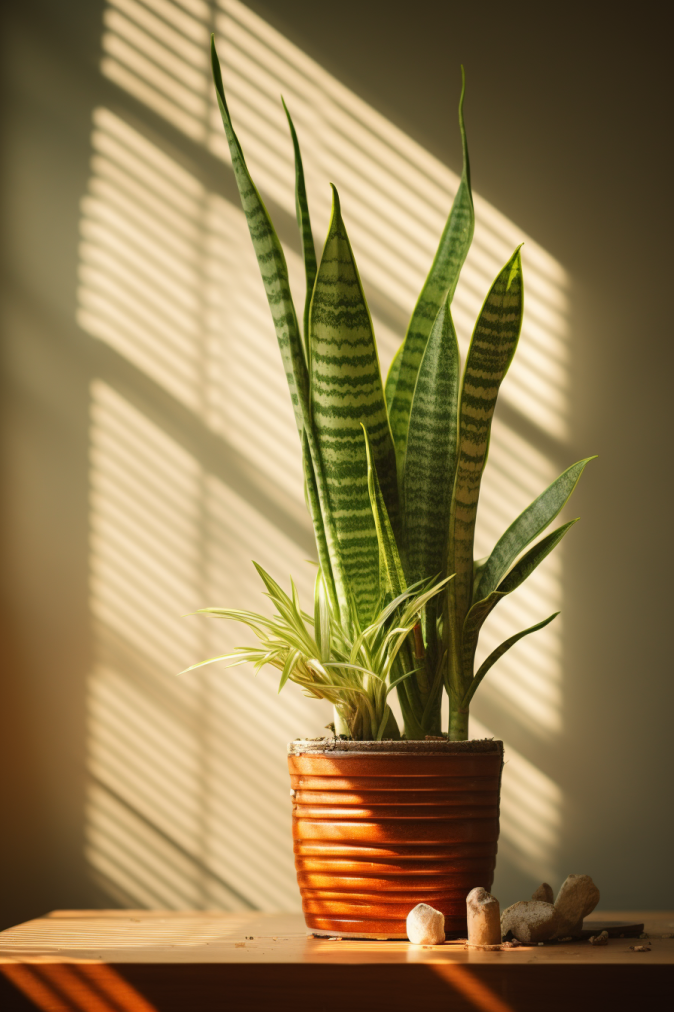
Seasonal Considerations
Adapting to seasonal changes is crucial for maintaining optimal conditions for snake plants.
Light availability fluctuates throughout the year, and being attentive to these variations ensures the well-being of your plant.
Monitoring light requirements
Seasonal shifts impact the intensity and duration of sunlight.
During the summer, days are longer, providing more sunlight, while winter days may be shorter and less bright.
It’s essential to monitor your snake plant’s light requirements during these changes to ensure it receives the appropriate amount of light for healthy growth.
Adjusting light exposure
As seasons change, consider adjusting the placement of your snake plant.
During the brighter months, you may position it near windows with more direct sunlight.
In contrast, during darker months, placing it in well-lit areas or supplementing it with artificial light becomes crucial.
Adapting to these variations helps maintain an optimal balance and prevents issues related to inadequate or excessive light exposure.
Indoor vs outdoor considerations
For snake plants kept outdoors, seasonal transitions are more pronounced.
Be mindful of temperature changes, especially during winter, and protect the plant from potential frost.
When moving the plant indoors for the colder months, ensure it still receives sufficient light, either from natural or artificial sources.
Regular monitoring and adjustment
Consistent monitoring of your snake plant’s condition is essential.
Observe for any signs of stress or changes in growth patterns.
If you notice pale leaves or slow growth, it may indicate a need for adjustments in light exposure.
Rotate the plant regularly to ensure even light distribution and maintain its symmetrical appearance.
Supplementing with artificial light
During seasons with limited natural sunlight, consider supplementing with artificial light sources.
Fluorescent or LED lights can provide the necessary light energy for photosynthesis.
Adjust the duration and intensity based on the specific needs of your snake plant, ensuring it receives consistent light throughout the year.
- Read also: A Guide on How to Repot a Snake Plant
- Read also: How to Propagate Snake Plants in Water
Conclusion
Ensuring the optimal growth and well-being of snake plants hinges on a thorough understanding of their light requirements.
By furnishing suitable light conditions and incorporating artificial light sources when needed, you contribute to the thriving success of your snake plant.
This thoughtful approach to lighting considerations lays the foundation for a healthy and vibrant indoor companion.
FAQs
Snake plants can survive in low light conditions, but their growth may be slower, and their leaves may become elongated.
Snake plants prefer to be watered less frequently, so it’s best to wait until the soil is dry before watering them again.

